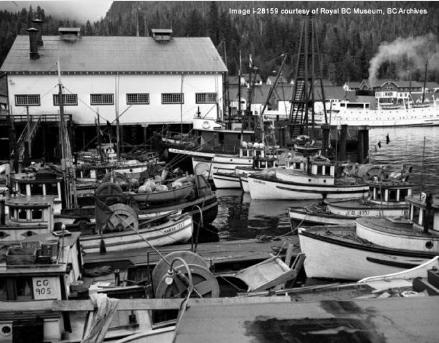 |
|
Small Craft Route - Butedale - Mile 462 |
|
Imagine this - it’s just coming on dark, some fall evening in the 1970s. You’ve traveled for many miles along these empy and winding channels, never seeing another boat, or house, or, except for the occasional navigational light, even a sign that man even existed. Then you come around the corner at Mile 462, and then there’s this town, tucked in this little cove, all lit up, shining out at the dark night falling all around. Eager for company, maybe even a hot meal, you stop in, tie up at the float, walk up the ramp, only to discover that... there was almost no one there. Originally built in 1911, Butedale was one of dozens of remote canneries up and down the British Columbia coast at a time when salmon and logging were the flagship industries of the coast. Each summer the steamships of xxx would bring thousands of workers from the towns of southern British Columbia north to the remote canneries for their summer lives of bunkhouse living, fishing, or working in the processing line. Tucked into remote corners of winding inlets, each had to be a little self sufficient town all to itself, able to keep its workers fed, the lights on, and the canning machines operating while the fish were running. Sadly, poor management and damaging logging practises took their toll on fish runs, and fish transport vessels or packers with refrigerated sea water systems were able to take the fish to places like Prince Rupert where a cannery could operate without the expense of basically creating and maintaining a whole town to support it. The Canadian Fishing Company, who owned Butedale, stopped canning in the mid 1950’s, but still maintained the huge facility with warehouses, bunkhouses, messhalls, etc. for fishermen to store and maintain their boats and gear. Since then Butedale has steadily gone downhill. Numerous groups have come up with various schemes and dreams to make it a resort, but the immense job and cost of repairing and maintaining the pilings, wharves, buildings were just too much. But for years, especially at night, it seemed like a bustling little town, a stark contrast to the many dark miles on either side - all because it was all water powered - a long cedar with steel bands penstock - like a huge pipe - ran from the lake hundreds of feet above the cannery, down to a powerhouse, so there was all the free electricity one could want. Great link to a recent Butedale visit: http://oceanflyers.com/?p=1409 |
 |
||||||||
Butedale in its heyday, around 1950 with the dock full of gillnetters and a fish packer tied close to the dock. Notice the white steamer in the distance - this is probably the Canadian Pacific Railroad steamer Princess Marguerite. This was a busy busy place during the summer fishing season! |
|||||||||
 |
|||||||||
This is Butedale, when I stopped by for the first time, on our way north with our gillnetter in May of 1972. There was a float, fuel and water at the dock, and the store shelves were stocked. But there was only a caretaker and his wife there. It was amazing to walk around the cannery - essentially a whole little town. |
|||||||||
 |
||||
Butedale in 1997 - the buildings are definitely starting to fall down, there isn't a float any more, and the dock is starting to collapse into the bay. But after this at least one more group of hopeful entrepreneurs tried to rehab the old cannery into a resort. |
||||